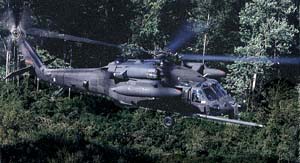

The sailors wrestling the massive spiked mine across the deck of the Iran Ajr had no idea they were being watched. But hovering a stone's throw above them in the dark, a U.S. Army warrant officer followed their every move through a thermal imager. Like a baseball announcer, he gave a running description of the events unfolding below him to a U.S. Navy admiral aboard the command ship LaSalle, steaming miles away, over the horizon. When the warrant officer reported the mine was about to be dropped overboard, the admiral decided he had heard enough. "Stop the mining," he ordered. Within seconds the deck of the Iran Ajr exploded as a pair of armed AH-6 Little Bird helicopters swept down and raked the Japanese-built cargo ship with 7.62mm Miniguns.
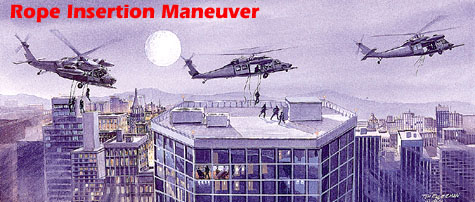
"They didn't know what was happening," recalls one airborne observer. "They couldn't see or hear the helicopters. They would run in the corner and try to hide." But after a quiet half-hour, the Iranians went back to work, and the admiral, with permission from Washington, told the helicopters to stop the mining and immobilize the ship. The AH-6s opened fire with their Miniguns and Hydra 70mm rocket systems. One helicopter strafed the wheelhouse and killed a man firing a weapon from the bridge. The other shot a rocket into the stern that killed a sailor in the engine room. The crew abandoned the minelayer, and one AH-6 left to track down an inflatable motorboat that had run off during the attack. With night vision goggles, the two aviators found the boat apparently adrift. Suddenly, a pile of rags in the boat turned into a man firing a gun. The Gatling gun on the AH-6 quickly ended the fight. The AH-6 rejoined the other, first around the Iran Ajr and then on the small deck of the frigate USS Jarrett from which the flight had been launched.
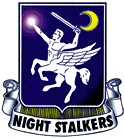 For the men of Task Force 160, Operation Earnest Will was just another day at the office, albeit a more exciting day than most. For strategists those fateful moments on Sept. 21, 1987, meant oil tankers could keep moving despite the ongoing war between Iran and Iraq. More important, the attack gave the world hard evidence that Iran was engaged in mine warfare.
For the men of Task Force 160, Operation Earnest Will was just another day at the office, albeit a more exciting day than most. For strategists those fateful moments on Sept. 21, 1987, meant oil tankers could keep moving despite the ongoing war between Iran and Iraq. More important, the attack gave the world hard evidence that Iran was engaged in mine warfare.
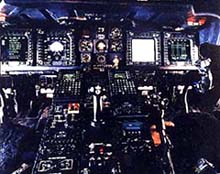
The MH-60K flight deck is designed for flying fast and low at night and in near-zero-visibility weather. Photo by Frank Colucci.
The operation also provided a glimpse of the Pentagon's most elite asset--the U.S. Army's special operations aviation unit--the Night Stalkers. Composed of specially trained Army aviators who take their orders from the Joint Chiefs of Staff.
Now designated the 160th Special Operations Aviation Regiment (SOAR) and headquartered at Fort Campbell, Ky., the Night Stalkers have about 1800 people and fly the world's most sophisticated helicopters. The 160th keeps aircraft ready to deploy on 4 hours' notice from Fort Campbell, Hunter Army Airfield near Savannah, Ga., and Howard Air Force Base in Panama, and it routinely fields training detachments of four to 12 aircraft around the world.
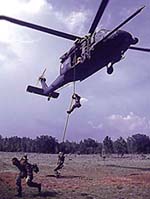 The AH-6 and MH-6 Little Birds, MH-60 Black Hawks, and MH-47 Chinooks of the Night Stalkers insert, extract and support special operations forces deep in hostile territory. U.S. Army Rangers and Navy SEAL teams are the chief customers for the 160th's express delivery service, which can put troops in or take them out of harm's way within 30 seconds of the scheduled time. Night Stalkers saw action in Grenada during Operation Urgent Fury in 1983 and Panama during Just Cause in 1989, and took commandos to hidden sites in Kuwait and Iraq during Desert Storm in 1991.
The AH-6 and MH-6 Little Birds, MH-60 Black Hawks, and MH-47 Chinooks of the Night Stalkers insert, extract and support special operations forces deep in hostile territory. U.S. Army Rangers and Navy SEAL teams are the chief customers for the 160th's express delivery service, which can put troops in or take them out of harm's way within 30 seconds of the scheduled time. Night Stalkers saw action in Grenada during Operation Urgent Fury in 1983 and Panama during Just Cause in 1989, and took commandos to hidden sites in Kuwait and Iraq during Desert Storm in 1991.
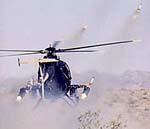 It's dangerous work. The Night Stalkers lost two Black Hawks and five aircrew in the disastrous daylight firefight in Mogadishu, Somalia, in October 1993--but were back in action in Haiti during Operation Restore Democracy in 1994.
It's dangerous work. The Night Stalkers lost two Black Hawks and five aircrew in the disastrous daylight firefight in Mogadishu, Somalia, in October 1993--but were back in action in Haiti during Operation Restore Democracy in 1994.
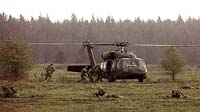 Night Stalkers are volunteers, specially selected, trained and equipped for missions with high personal risk and high operational or strategic payoff. "It's typically a no-fail mission," says a former Night Stalker. While a conventional unit might legitimately abort a mission due to bad weather, equipment failure or heavy resistance, special ops generally have no alternatives. "It's a one-shot. It has to be first-time." The motto of the 160th is simply, "Anytime, Anywhere, Night Stalkers Don't Quit."
Night Stalkers are volunteers, specially selected, trained and equipped for missions with high personal risk and high operational or strategic payoff. "It's typically a no-fail mission," says a former Night Stalker. While a conventional unit might legitimately abort a mission due to bad weather, equipment failure or heavy resistance, special ops generally have no alternatives. "It's a one-shot. It has to be first-time." The motto of the 160th is simply, "Anytime, Anywhere, Night Stalkers Don't Quit."
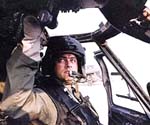
Commissioned officers can be flight lead qualified, but more often, it is warrant officers who take the pilot's seat of lead aircraft. Photo by Greg Williamson.
Commissioned and warrant officer aviators come to the Night Stalkers with a minimum of 1000 flight hours including 100 hours on night vision goggles. The initial assessment process includes written and physical exams, a psychological interview, and a pressured night check ride. It eliminates 50 percent to 60 percent of the applicants. The Green Platoon, or Selection and Training Detachment, then puts its students through three weeks of grueling survival, escape, resistance and evasion school, plus three weeks of academic training, two weeks of intensive navigation training on the cheap-to-fly MH-6C, and six weeks of training on the Little Bird, Black Hawk or Chinook.
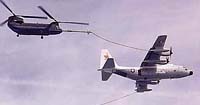 The "basic mission qualified" aviator can be a copilot on operational missions or pilot-in-command for training flights, and continues training in one of the four operational battalions. In 12 to 18 months, a pilot is "fully mission qualified" to command an aircraft on an operational mission. Flight lead status is conveyed on only the most experienced aviators. The commissioned air mission commander with abort authority would typically be in another helicopter.
The "basic mission qualified" aviator can be a copilot on operational missions or pilot-in-command for training flights, and continues training in one of the four operational battalions. In 12 to 18 months, a pilot is "fully mission qualified" to command an aircraft on an operational mission. Flight lead status is conveyed on only the most experienced aviators. The commissioned air mission commander with abort authority would typically be in another helicopter.
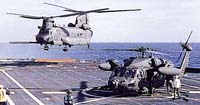
Tearing an MH-47 down to fit a C-5 jet transport and rebuilding it at the other end wastes hours. The Night Stalkers first tried aerial refueling in 1985 and made it operational in 1989.
Rubber raiding boats can sit fully loaded in the cabin of an MH-47 to float out seconds after a water landing. The same boat can be tied to the belly of an MH-60 or pitched out partially inflated to deploy teams in other situations. Special operations troops fast-rope to the ground in seconds for quick insertions in obstructed landing areas. The Night Stalkers have their own systems integration and maintenance office to develop and field new equipment.
The AH-6 gives the Night Stalkers a fast, quiet weapons platform. Its fraternal twin MH-6 fitted with external bench seats can haul six troops. AH-6s were the first Army helicopters in combat in Grenada in October 1983. Six of the secret Little Birds were rolled from Air Force C-130s at the Port Salines Airfield and were promptly photographed by wire services. One gunship was shot down supporting U.S. troops in daylight during the invasion of Grenada. Another, hit during the attack on the Panamanian command headquarters, crashed to the street and skidded through the entrance where the sentry immediately surrendered to the two crewmen--all three were evacuated by an armored personnel carrier. AH-6s and MH-6s supposedly prowled the streets of Baghdad during Desert Storm. They remain a versatile, deployable asset. The weapons plank on the AH-6G, for example, can carry Hellfire laser-guided missiles.
The rugged, powerful Black Hawk is the Army's standard utility helicopter and typically provides cabin seating for 15. It can shoot Hellfire rockets from its detachable "wings," and the Night Stalkers have configured some with rocket pods and one or two forward-firing 30mm Chain Guns.
The MH-47D routinely flies 6-hour missions. It can seat 33 or 44 troops. The new MH-47E adds another thousand gallons of fuel and has the same "glass cockpit" as the special ops Black Hawk. Unlike ordinary Army lift battalions, the Night Stalkers use the big MH-47 as an assault helicopter just like the MH-60, flying low to fast-land or fast-rope troops on target. SEAL teams and Marine Corps expeditionary units deploy from carrier-capable HH-60G Seahawks and CH-53E Super Stallions. However they fly, the Night Stalkers represent the best America has to offer, and they remain a critical national asset in an unstable world.